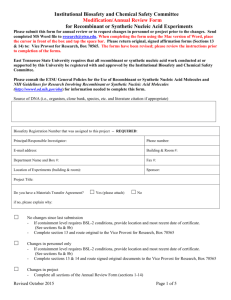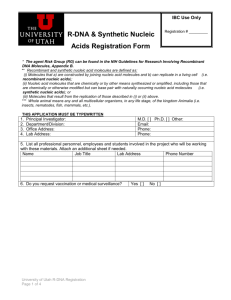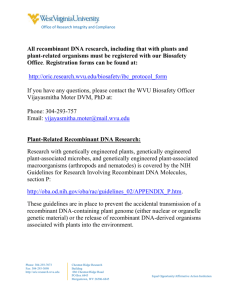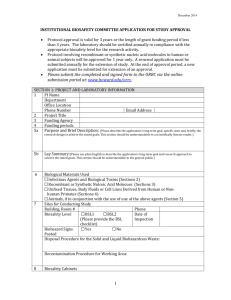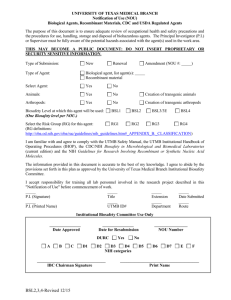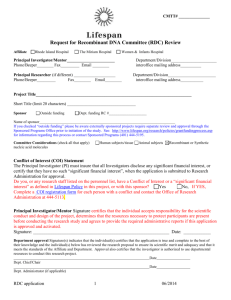or synthetic nucleic acid molecules
advertisement
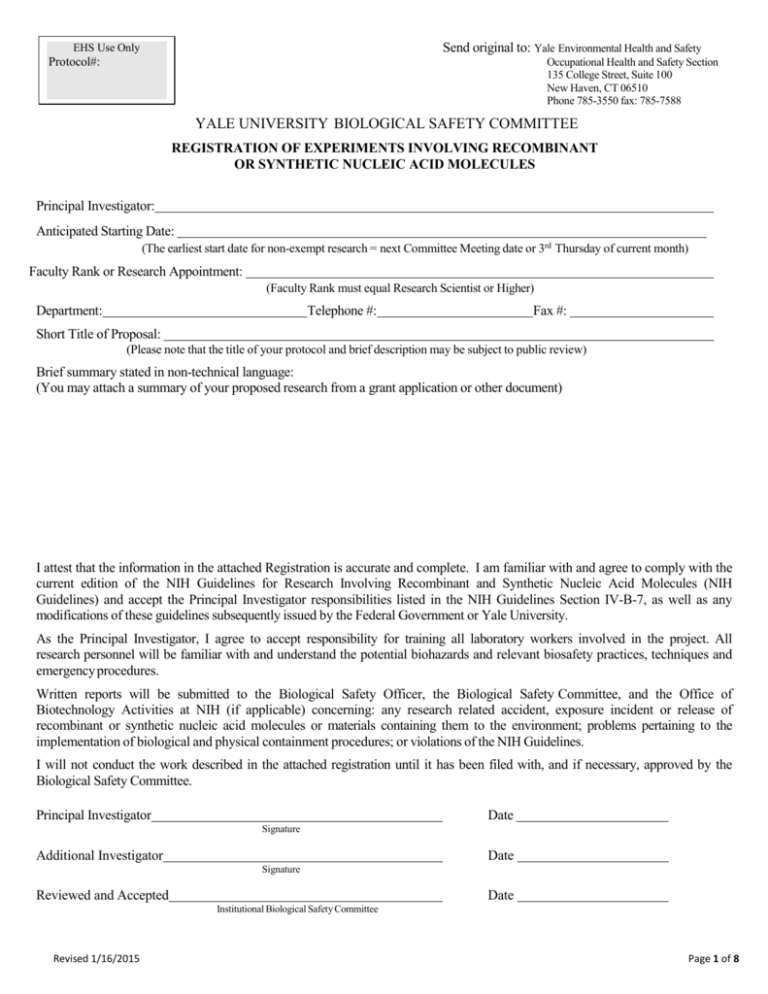
Send original to: Yale Environmental Health and Safety EHS Use Only Protocol#: Occupational Health and Safety Section 135 College Street, Suite 100 New Haven, CT 06510 Phone 785-3550 fax: 785-7588 YALE UNIVERSITY BIOLOGICAL SAFETY COMMITTEE REGISTRATION OF EXPERIMENTS INVOLVING RECOMBINANT OR SYNTHETIC NUCLEIC ACID MOLECULES Principal Investigator: Anticipated Starting Date: (The earliest start date for non-exempt research = next Committee Meeting date or 3rd Thursday of current month) Faculty Rank or Research Appointment: (Faculty Rank must equal Research Scientist or Higher) Department: Telephone #: Fax #: Short Title of Proposal: (Please note that the title of your protocol and brief description may be subject to public review) Brief summary stated in non-technical language: (You may attach a summary of your proposed research from a grant application or other document) I attest that the information in the attached Registration is accurate and complete. I am familiar with and agree to comply with the current edition of the NIH Guidelines for Research Involving Recombinant and Synthetic Nucleic Acid Molecules (NIH Guidelines) and accept the Principal Investigator responsibilities listed in the NIH Guidelines Section IV-B-7, as well as any modifications of these guidelines subsequently issued by the Federal Government or Yale University. As the Principal Investigator, I agree to accept responsibility for training all laboratory workers involved in the project. All research personnel will be familiar with and understand the potential biohazards and relevant biosafety practices, techniques and emergency procedures. Written reports will be submitted to the Biological Safety Officer, the Biological Safety Committee, and the Office of Biotechnology Activities at NIH (if applicable) concerning: any research related accident, exposure incident or release of recombinant or synthetic nucleic acid molecules or materials containing them to the environment; problems pertaining to the implementation of biological and physical containment procedures; or violations of the NIH Guidelines. I will not conduct the work described in the attached registration until it has been filed with, and if necessary, approved by the Biological Safety Committee. Principal Investigator Date Signature Additional Investigator Date Signature Reviewed and Accepted Date Institutional Biological Safety Committee Revised 1/16/2015 Page 1 of 8 Principal Investigator Protocol Safety Assurance Statements: My laboratory has all relevant and required safety equipment for the safe conduct of the Yes No research described in this application Yes No Personal protective equipment has been provided free of charge to those working on this project in the appropriate sizes Yes No I will supervise lab staff to ensure that the required biocontainment work practices and techniques are employed. I will correct any work practices and conditions that will result in the release of recombinant DNA materials. All personnel assigned to this project have completed all applicable EHS laboratory safety training classes (i.e. Biosafety Part 1 and Part 2, Bloodborne Pathogens for lab personnel, Lab Chemical Safety) Emergency exposure and spill response procedures have been outlined and reviewed with the laboratory staff Yes No Yes No Yes No As the Principal Investigator, I have completed the Yale EHS online class entitled “PI Orientation to the Yale Biological Safety Manual” (and any other applicable training classes if I am participating in the conduct of laboratory research) Yes No My laboratory will follow the emergency response protocols as detailed in the Yale University Biosafety Manual Yes No All incidents and exposures involving recombinant or synthetic nucleic acid molecules will be promptly reported to Yale EHS for evaluation Yes No All non-exempt experiments involving the use of recombinant or synthetic nucleic acid molecules will not be initiated until approved by the Yale University Biological Safety Committee Yes No N/A Any specific medical surveillance requirements for this protocol (i.e. immunizations, serum storage) have been communicated to all personnel involved in this project. High Risk Recombinant or Synthetic Nucleic Acid Molecule Research Experiments Yes No Does this rDNA protocol involve the transfer of recombinant or synthetic nucleic acid molecules to human subjects? Yes No Does the rDNA protocol involve the cloning of molecules toxic to vertebrates with an LD50 of < 100 ng/kg body weight? Yes No Does the rDNA protocol involve the deliberate transfer of a drug resistance trait to microorganisms that are not known to acquire it naturally if such acquisition could compromise the ability of the drug to control disease? (Example: Placing a gene for Ampicillin resistance in E. coli K12 would not meet this criteria, but placing an gene for Ampicillin resistance in Listeria monoctyogenes would). Yes No Does this experiment involve the use of a Select Agent? Yes No Does this experiment involve the use of greater than 10 Liters of culture? Principal Investigator Date Signature Revised 1/16/2015 Page 2 of 8 Dual Use Research In reviewing registrations, the Yale IBC considers "dual use" potential, namely the potential for research projects with a beneficial purpose to provide knowledge, products or technologies that could be directly misapplied to pose a threat to public health and safety, agricultural crops and other plants, animals, the environment, or material. For a full discussion of this topic, consult Dual Use Research and the National Science Advisory Board http://osp.od.nih.gov/office-biotechnology-activities/biosecurity/dual-use-research-concern Will you be conducting research that directly uses nonattenuated forms of one or more of the following agents? Yes No. If yes, please check the agent involved: Avian influenza virus (highly pathogenic) Bacillus anthracis Botulinum neurotoxin (in any quantity) Burkholderia mallei Burkholderia pseudomallei Ebola virus Foot-and-mouth disease virus Francisella tularensis Marburg virus Reconstructed 1918 influenza virus Rinderpest virus Toxin-producing strains of Clostridium botulinum Variola major virus Variola minor virus Yersinia pestis Do any of your experiments fall into any of the following experimental categories? Yes No If yes, please check all that apply: Enhances the harmful consequences of the agent or toxin; Disrupts immunity or the effectiveness of an immunization against the agent or toxin without clinical and/ or agricultural justification; Confers to the agent or toxin resistance to clinically and/or agriculturally useful prophylactic or therapeutic interventions against that agent or toxin or facilitates their ability to evade detection methodologies; Increases the stability, transmissibility, or the ability to disseminate the agent or toxin; Alters the host range or tropism of the agent or toxin; Enhances the susceptibility of a host population to the agent or toxin; and Generates or reconstitutes an eradicated or extinct listed agent or toxin. Provide other knowledge, products or technologies that could be directly misapplied to pose a threat to public health and safety, agricultural crops and other plants, animals, the environment, or material. Comment on aspects of your research, if any, with potential for dual use: Revised 1/16/2015 Page 3 of 8 Registration of Research Experiments with Recombinant or Synthetic Nucleic Acid Molecules I. Specific Information: A. Will experiment be carried out in E. coli or other prokaryotic host? If yes, specify: Yes No Host strains: Vectors: Inserted DNA (include names of genes and organisms from which they were cloned): Yes No Will an attempt be made to express a foreign gene? If yes, what protein will be produced? Will whole virus or provirus be cloned? Yes No Will the research involve the use of antibiotic selection markers? Yes No If yes, list the markers and microbial agents used (e.g. neomycin resistance marker in E. coli) B. NIH Guideline Section: Recommended Biosafety Level: Will experiment be carried out in eukaryotic cells? If yes, specify: Yes No Host cells Vectors Inserted DNA Will an attempt be made to express a foreign gene? Yes No If yes, what protein will be produced? Helper virus or packaging cells if used What fraction of a eukaryotic viral genome is contained in the recombinant or synthetic nucleic acid molecules (including vector and packaging cell line)? Check appropriate range: <1/2 >1/2 but <2/3 >2/3 NIH Guideline Section: Recommended Biosafety Level: Will the research involve the use of antibiotic selection markers? Yes No If yes, list the markers and microbial agents used (e.g. neomycin resistance marker in E. coli) Revised 1/16/2015 Page 4 of 8 For all Recombinant or Synthetic Nucleic Acid Molecule Experiments Name/type of rDNA Vector (provide name and company or person providing it). Provide reference also if available. Vector Map (attach from website) Percent of the pathogen genome present in the vector (kilobases of the parent pathogen in the vector and packaging cell combined) C. Will experiment be carried out using whole plants or animals (vertebrate and invertebrate) as hosts? Yes No If yes, specify: Plant or animal hosts Vectors Inserted DNA What fraction of a eukaryotic viral genome is contained in the recombinant or synthetic nucleic acid molecules (including vector and packaging cell line)? <2/3 >2/3 Yes No Will transgenic plants or animals be constructed or used? Has a Yale IACUC registration been filed for your research experiments with vertebrate animals? Yes No NIH Guideline Section: Recommended Biosafety Level: Will you cross-breed two or more genetically modified rodents or plants? If yes, please answer the questions below: Yes No Note: Generation of transgenic rodents by breeding to create a new strain shall be EXEMPT from the NIH Guidelines if the following criteria are met. Yes No Both parental rodents can be housed under BSL1 containment; AND Yes No Neither parental transgenic rodent contains the following genetic modifications: Incorporation of more than 50% of the genome of an exogenous eukaryotic virus from a single family of viruses; OR Incorporation of a transgene that is under the control of a gammaretroviral long terminal repeat (LTR); AND Yes No The transgenic rodent that results from this breeding is not expected to contain more than 50% of an exogenous viral genome from a single family of viruses. Revised 1/16/2015 Page 5 of 8 For recombinant or synthetic nucleic acid molecule experiments, do the genes involved or expressed involve potential: Toxicity Yes No N/A Cell cycle/Cell division regulators Yes No N/A Provide full name of genes in each category (provided the full scientific names for all of the abbreviations on the form) Regulatory genes for transcription and Yes No N/A cell activators (cytokines, lymphokines, and tumor suppressors) Structural Proteins, Membrane Proteins Yes No N/A Enzymatic Proteins and Metabolic enzymes Yes No N/A Cell growth Yes No N/A Tracking genes (i.e. GFP) Yes No N/A Allergenicity or other risk to research personnel Yes No N/A Oncogenicity (cellular or viral oncogenes) Yes No N/A Other potential risk to researchers handling the recombinant or synthetic nucleic acid molecules in this application? Yes No N/A II. Describe the Biohazard Potential of these Experiments: Are special medical surveillance practices recommended? Please note: Anyone who is currently pregnant or immunosuppressed must contact Employee Health (432-7978) before working with the agent in question. Revised 1/16/2015 Page 6 of 8 Registration of Research Experiments with Recombinant or Synthetic Nucleic Acid Molecules III. Description of Experiment: 1) Provide the goals of the research and potential benefits; 2) Include sufficient detail to clarify the scientific basis of the work; 3) Note approximate start date for each phase of the work. 4) Give references if appropriate. IV. LOCATION (Buildings, Room #s): (Please include ALL locations where research with recombinant or synthetic nucleic acids will occur, including animal facilities and core research facilities, such as the Cell Sorting, Electron Microscope, Confocal Microscope, or Genomics Core Laboratories): V. PERSONNEL (Names, Status and Telephone): Revised 1/16/2015 Page 7 of 8 RESEARCHER EXPERIENCE FORM (Required for the PI and each researcher listed in Section V above under Personnel) Name: Job Title: Principal Investigator: Date: Education: Date Institution Major Area Degree Laboratory experience related to work with microorganisms or cell culture: Dates Revised 1/16/2015 Institution Description of work and name of microorganisms (include the genus and species) Page 8 of 8

